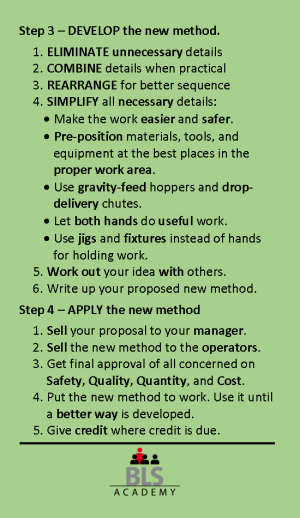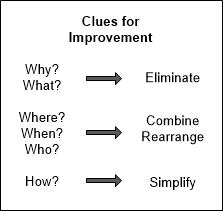
Job Methods - The Tool that
Strengthens Your Processes
Job Methods is the TWI program that trains leaders in how to improve their work processes and procedures. After obtaining process stability through the use of JI and JR, JM becomes a powerful tool to improve your processes for even greater performance gains. Like all the TWI programs, JM uses a 4-step method which is trained in five 2-hour sessions. The focus of JM is to identify and question every detail of the job – every step, motion or action – to determine the best way to do the job with the currently available manpower, machines, and materials. JM is applicable to all types of work which involve the use of your hands, moving materials or operating machines, actions found in a majority of the jobs in the workplace. There are three main components to the JR progrrma
- 4-Step JM Method Improving Methods – Used to capture and question the current state of doing and task and developing and selling improvements.
- Job Methods Questions – These six questions form the basis of improvement in JM.
- Job Methods Breakdown – The form that the current state is captured and questioned and then is used to capture improvements.
- JM Proposal – A form that captures and communicates the proposed improvements to all the stakeholders involved.
Job Methods provides the leader with a 4-step process for improving his or her processes or specific tasks. The first step is to Break Down the Job. Using the JM Breakdown Form the leader captures the details of the job exactly as it’s currently being done in the present method. The JM breakdown differs from the JI Breakdown in purpose and detail. The purpose of the JI breakdown is to remind the instructor of the important steps, key points and reasons for the key points, so he doesn’t forget to tell and show the learner anything important or key. The JM breakdown is to identify all the activity required to do the job, so it can be analyzed to determine what can be improved. The level of detail for a JM Breakdown is usually much greater than that required for a JI Breakdown. The more detail captured in Step 1, the easier it is to make improvements in Step 3.
Step 2 – Question Every Detail – has the leader review every activity identified in Step 1 asking six basic questions. Job Methods uses these questions to help identify opportunities for improvement. By following the questioning process, ideas for improvement are uncovered and captured on the breakdown.
In Step 3 – Develop the New Method – the leader creates the new method. Using the improvement ideas captured during Step 2 and any others that might be generated in Step 3, the leader develops the new method capturing it on the reverse side of the JM Breakdown. From the analysis in Step 2, the improvement ideas to eliminate, combine, rearrange, and simplify the work are now written into the new method.
Lastly, in Step 4 – Apply the New Method, the leader now develops his improvement proposal and sells it to the team, his leader, and other concerned groups, before implementing. This extra effort will lead to a smoother implementation of the improvements with less resistance from those involved. It’s also critical in this step that the leader give credit when due, and finally, implement the improvements.
Job Methods uses a very specific questioning method to analyze and create the future state. The six questions have been developed so the leader can discover what actions or details to eliminate, combine, rearrange, or simplify in the task. Below are the questions asked in step two – question every detail:
- Why is it necessary?
- What is it’s purpose?
- Where should it be done?
- When should it be done?
- Who is best qualified to do it?
- How is the ‘best way’ to do it?
These questions are asked in this exact order because they are the most efficient method of finding the best improvements. You ask first of every detail, “Why is it necessary?” because if you find out it’s not necessary, you can eliminate it right then. The second question, “What is it’s purpose?” is a check question for question 1. The detail may not be necessary but its purpose may be fulfilling a customer requirement. You’d not want to eliminate the detail then. The next three questions help develop clues for combining or rearranging the tasks, which could be temporally (lump them together or rearranging the sequence of execution) or spatially (where the task is performed physically in the work area). The last question, “How is the ‘best way’ to do it? is asked last. You do not want to find the best way to do a action until you’ve answered the first five questions. Any changes coming from those questions will impact the last question. Below is how the six questions drive clues for improvement:
Many people worry that they will not be able to come up with good improvement ideas. Using these questions, following them from 1 through 6, will generate a tremendous amount of creative ideas and drive improvement.
The JM Breakdown is both a form and a process. The form is used to capture the present state in Step 1. By capturing every detail, every activity in the task, you can begin to see what is value added and what is not. More details details helps you find more and better improvement ideas. The first column allows you to number the details. In the second column, you list all the details in the method, breaking out all the actions. In the third column you can list the distance traveled or some list the time required. In the next column you can list anything that might useful when analyzing the method – time, tolerance, safety, defects, etc. After capturing the current method, you can move on to step 2, question every detail.
The form again supports the process. As you ask the six questions for each detail, improvement ideas might come to mind. The key is to write them down in the ideas column and check off in the question columns, which question led to the idea. That will help them determining whether to eliminate, combine, rearrange or simplify the method in the improved state. After capturing the improvement idea, then mark which improvement category it falls into in the last four columns.
The form is used for capturing and analyzing the current method as well as capturing the future method. Not all of the columns will be used when developing the future method.
The JM Proposal is a critical part of Step 4 – Apply the New Method. Again, the proposal is a simple form that let’s you communicate your intent and the benefit and a brief summary of the changes. Often, organizations will route the proposal through all the stakeholders to ensure that everyone understands and accepts the proposed changes. By submitting it the improvement proposal to the stakeholders, not only with they get a chance to review the ideas, but their input may help improve the plan.
Benefits You Can Achieve Using Job Methods



